Introduction
Website traffic data tells crucial stories that impact teams across an organization and industries.
Investors can use traffic data to gauge prospects, agencies can use it to pitch clients, and security teams can use it to protect their assets.
But accessing, organizing, and sharing this data hasn’t always been easy.
Teams waste hours copying numbers between spreadsheets. While cutting, pasting, and sending links, emerging traffic trends slip past unnoticed.
APIs change that. They pipe fresh data straight into your teams’ tools without manual work.
This article reviews how the Trends API works, what kinds of data it delivers, and practical applications across marketing, sales, and investment teams.
Ready to plug into the Trends API? Let’s get started!
What is an API?
API stands for Application Programming Interface. This interface provides a gateway to extract data and share functionality between different software applications without manually logging into both apps.
Think of an API as a library with a helpful service desk.
You visit with a specific request for information. The librarian at the desk (the API) takes your library card (authentication key), searches through their vast collection (database), and brings back exactly the books you need.
You don't need to know where all the books are stored or how the catalog system works. You just make your request and receive the information you wanted.
The librarian handles all the complexity behind the scenes while providing a consistent, reliable way for you to access resources.
APIs almost always create these data connections behind the scenes. Have you checked the weather on your phone today? Reading social media comments on a third-party tool? If so, you’ve been accessing APIs without even knowing it.
Accessing raw Trends data for your business need works same way. The Trends API is the go-between, facilitating the seamless transfer of data from one application to another.
How do API integrations work?
While the “P” in “API” stands for programming, you don’t need technical expertise to initiate an API request. Here’s how to get rolling in just a few steps.
First, get your API Key. This long string of numbers and letters is unique and gives you access to the data you need.
(If you need an API key, please visit this page and fill out the request form).
Second, decide where you want to put the data you’ll get from the Trends API. Many users integrate Trends data with:
- Customer relationship management (CRM) tools (ex. Hubspot, Salesforce)
- Analytics software (ex. Tableau, Power BI)
- Spreadsheet software (ex. Google Sheets, Microsoft Excel)
- Custom in-house analytics systems
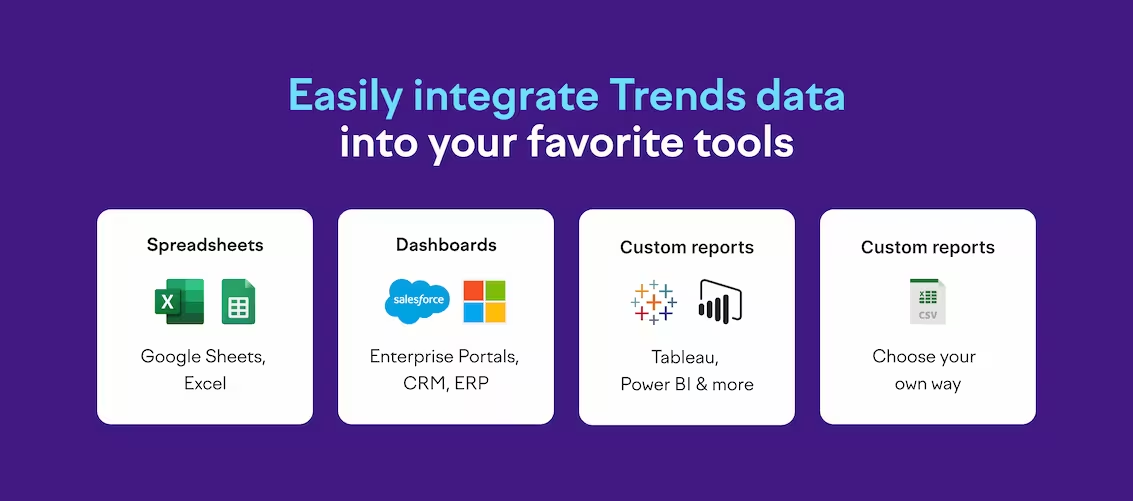
Then, use that Key and destination to make an API request. An API request needs a few key ingredients:
- Your API key for authentication – Get started by filling out the form on this page. Our team will reach out to help you get set up!
- The destination where you want the data (like a spreadsheet or dashboard) – check!
- Parameters that define exactly what you want:
- Which report you need
- What database to pull from
- Any filters to narrow down results (like data range, geographic region)
- The format you want the data in (ex. CSV)
The API processes these details and returns what you asked for in the destination that you’ve chosen. Bingo!
What data is available in the Trends API?
The Trends API delivers rich website analytics data that helps you understand traffic patterns and visitor behavior for any website. Trends accesses this data from 190+ countries and from as far back as 2017.
Here's what kinds of data you can access with the Basic API:
- Monthly visits and unique visitor counts that reveal audience size and domain traffic trends
- Pages per visit and average time spent, showing how engaged visitors are
- Mobile vs desktop traffic split, helping you spot device preferences
- Bounce rates that indicate content relevance
With Trends Basic API, you can access traffic data of up to 200 domains.
Premium API users can access 16 additional reports beyond basic traffic data, including:
- Daily traffic
- Weekly traffic
- Traffic sources
- Traffic destinations
- Subdomain traffic
- Subfolder traffic
- Top pages
- Traffic rank
- Purchase conversion
- Industry categories
- Geographic distribution
- Audience insights (demographics, interests, and social media usage)
To access this data, visit pages and fill out the form. After you send the form, someone from our sales or customer service team will reach out to get your started.
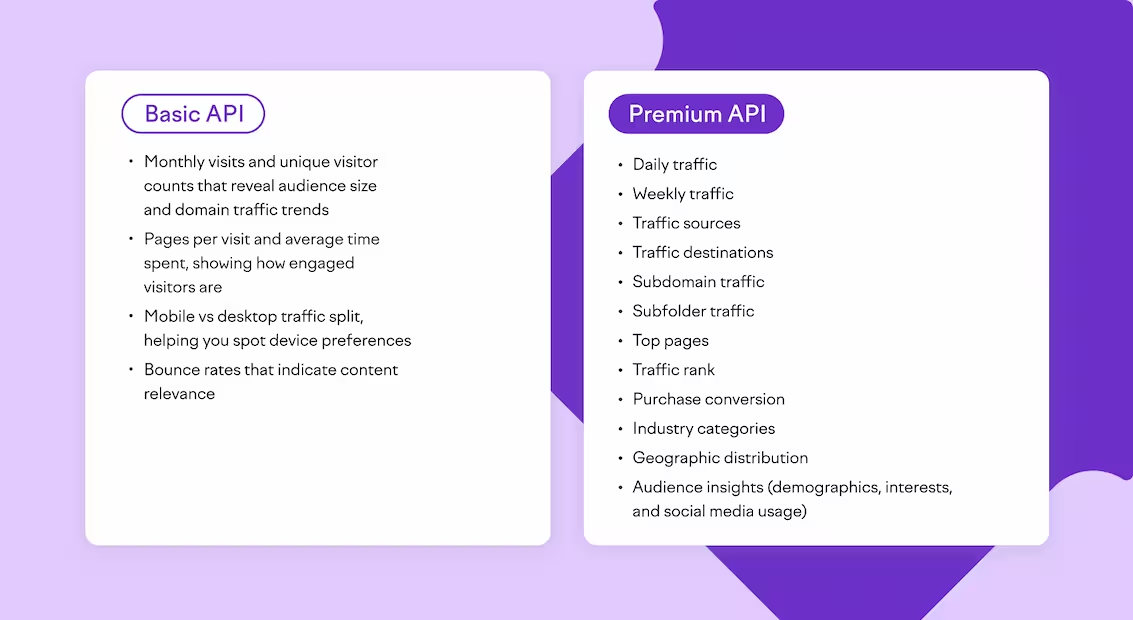
What are the benefits of using the Trends API?
The Trends API can transform how your business handles data operations and deliver benefits that positively impact your bottom line.
For example, you'll reduce countless hours of manual work by automating data collection and analysis. Your team can redirect their energy toward strategic initiatives rather than wrestling with spreadsheets and data entry.
And because the API request pulls data automatically, manual entry errors are a thing of the past.
By analyzing the data once it’s imported into your tool of choice, you can uncover valuable patterns and market opportunities that traditional research might miss.
Each benefit builds upon each other to give your team operational efficiency and a competitive advantage in the marketplace.
APIs serve organizations of every size — from boutique agencies tracking a handful of domains to global enterprises analyzing thousands of websites. The flexibility of API integration means you can scale your data needs as your business grows.
Here are more than 10 ways that the Trends API makes your work easier and your data better.
Want to access Trends API Data? Let’s get started!
Marketing Use Cases API Use Cases
Marketing teams need reliable data to make strategic decisions and measure campaign performance. The Trends API provides vital insights that help optimize marketing efforts and demonstrate clear results to stakeholders.
1. Create granular competitor reports
The Trends API can help you build a detailed analysis of your competitors' digital presence. Set up automated reports that reveal valuable insights. By monitoring up to 200 domains at once, you'll gain insights into market dynamics and visitor behavior that you won’t find anywhere else.
Daily and weekly traffic data shows what happens when competitors make moves in the marketplace. For example, see how a competitor’s latest product launch or social media campaign impacts their visitor numbers.
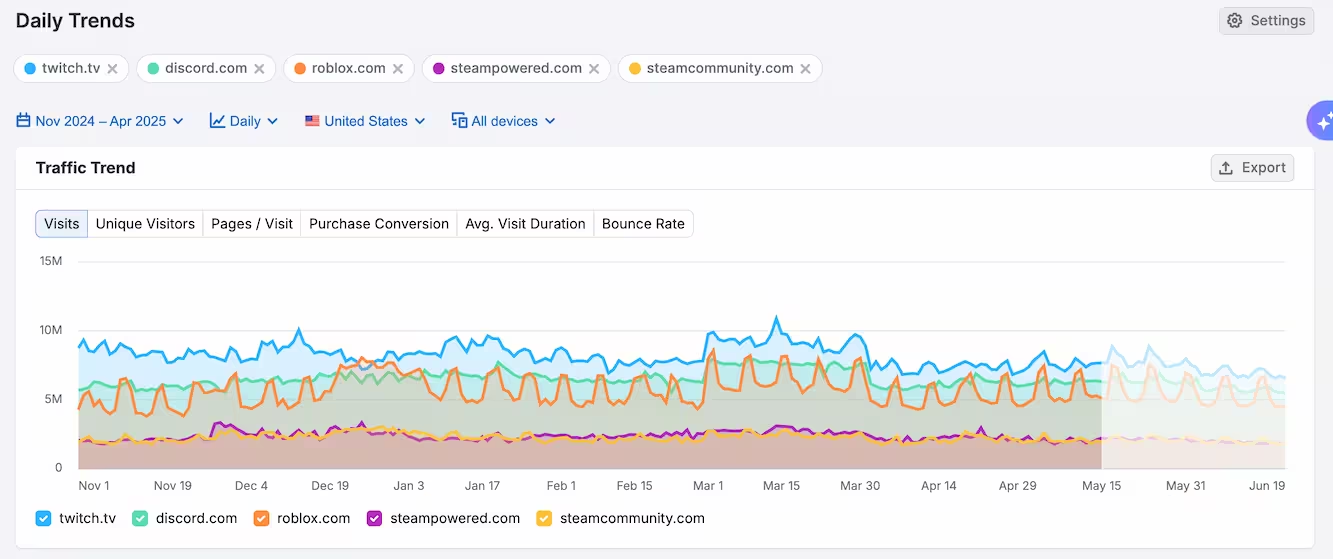
Geographic distribution data highlights where competitors concentrate their efforts and which regions remain untapped. You can spot expansion opportunities early by analyzing visitor behavior across different markets.
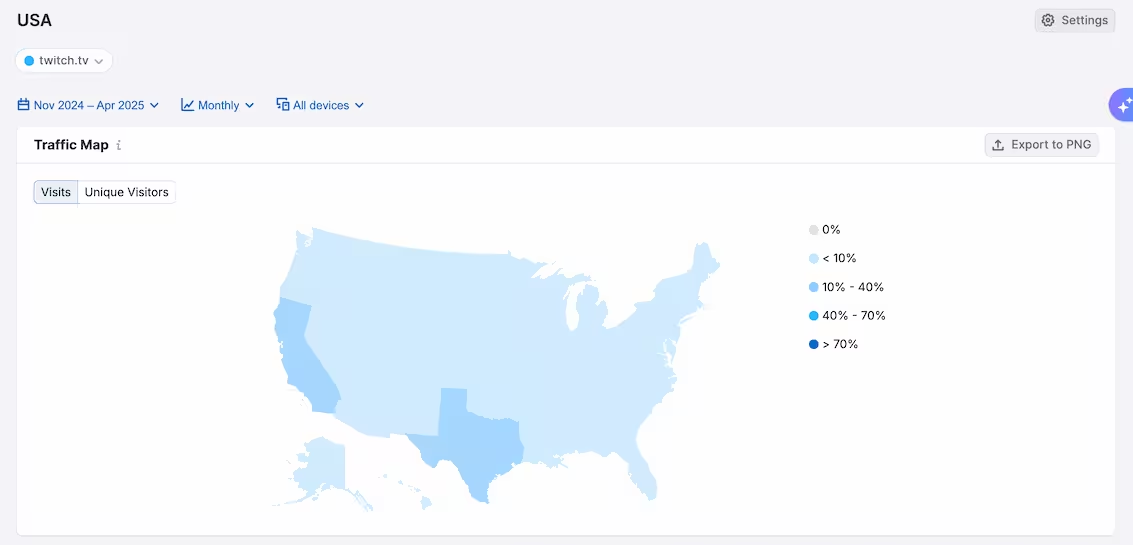
Historical data going back to 2017 puts current performance in context. By studying how similar companies have grown over time, you can establish realistic benchmarks based on actual market performance.
This ongoing monitoring helps you use real performance data to react quickly to market shifts. When your reports show improving engagement metrics on a competitor's site, analyze these changes and adapt successful elements for your own audience.
Regular benchmarking against competitor metrics lets you set your campaigns’ KPIs to be ambitious but achievable. Say the data shows competitors average 15% annual traffic growth. Use this knowledge to push ahead of 15% to a percentage that is realistically within reach for your team.
2. Develop internal monitoring dashboards
Transform your analytics by integrating Trends API data into your existing systems. Track daily traffic patterns, measure conversion rates, and gain deeper insights into your competitors’ audience demographics as they evolve.

Or get a time-lapsed view by monitoring quarterly performance shifts or year-over-year growth trends.
With either approach, your team gets immediate visibility into trends like device usage and social media engagement. These reliable data streams help you make confident decisions based on market behavior.
LaLiga, Spain's premier football league, discovered that monitoring traffic data can be useful beyond merely tracking the marketplace.
LaLiga integrated Semrush Trends API data with its content production tools to detect suspicious patterns across illegal streaming sites. When they spot unusual spikes or patterns that suggest piracy, they can take action quickly.
The results of this integration speak for themselves:
- 1.5 million illegal videos removed
- 372 websites blocked in Spain alone
- Extended their protection services to other leagues and broadcasters worldwide
This data-fueled approach helps LaLiga preserve revenue for legitimate broadcasters while ensuring fans get high-quality, legal ways to watch matches. Goal!
3. Improve lead qualification and scoring
Marketing teams use Trends API data to spot the most promising prospects in their pipeline. By analyzing how target companies' audiences interact with their websites, you build precise qualification models based on user activity.
Key qualification signals from prospect websites include:
- Monthly visitor counts and growth trends
- User engagement depth (time on site, pages viewed)
- Market reach and geographic distribution
- Traffic quality indicators like bounce rates
- Audience demographics and behaviors

Marketing teams create automated scoring frameworks that monitor these prospect behaviors. The system becomes a reliable guide for prioritizing outreach.
Consider companies expanding into new regions or capturing more audience share from competitors. Also, note data that shows increased engagement from your target demographic or reveals that a prospect's audience closely matches your current customer base. These insights help marketing teams direct resources toward opportunities most likely to convert.
Investors / Analysts API Use Cases
Investment decisions require deep market analysis and early detection of growth opportunities. The Trends API provides investors with valuable traffic metrics that often correlate with business performance.
4. Spot new opportunities early
Savvy investors look beyond traditional metrics. Tapping Trends API data will let you explore investment angles that most analysts miss.
Synaptic, a data intelligence platform, helps private investors evaluate potential investments using web traffic as a key performance indicator. Their platform combines Semrush API data with other metrics to provide a complete view of a company’s performance.
By analyzing traffic patterns across 300,000+ companies, Synaptic uses Semrush data to help investors:
- Compare organic vs. paid traffic ratios to evaluate marketing efficiency
- Identify companies gaining market share ahead of traditional metrics
- Use traffic growth as an early indicator of business performance
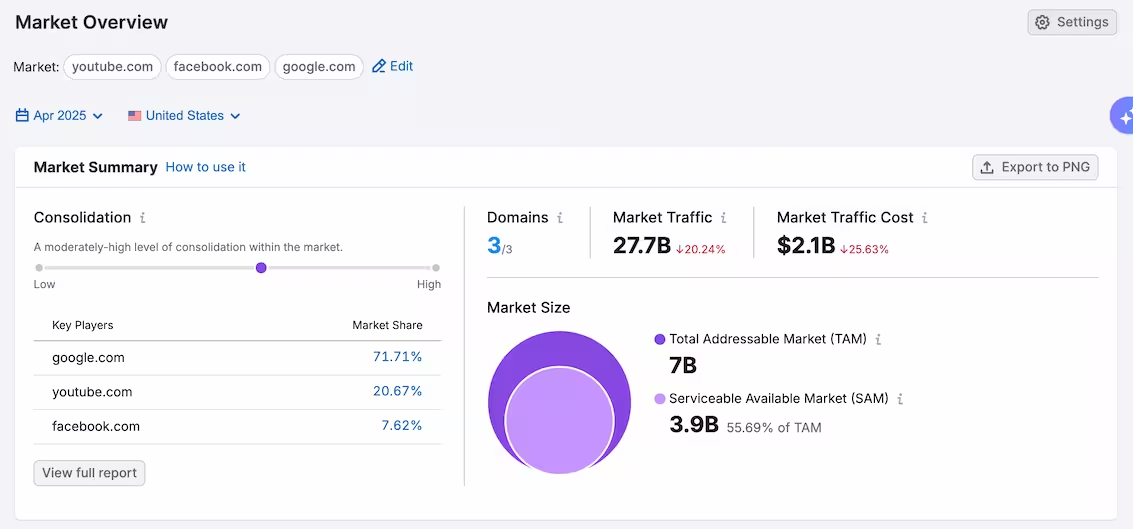
This approach has resulted in Synaptic’s clients making more confident investment decisions backed by objective data.
“Metrics provided by Semrush in combination with other alternative data points on Synaptic help investors get early signals on companies' performance, helping them find promising companies before they show up on anyone’s radar,” declares Rohit Razdan, Co-Founder at Synaptic.
5. Validate prospective investments and defend strategic decisions
When you’re ready to make a strategic investment (or two), you need real data to make smart decisions. That's why Flippa turned to the Trends API.
Flippa is an online marketplace that gives buyers insights into websites, stores, apps, and digital real estate for sale.
Soon after Flippa chose Semrush as its traffic insights provider, it began using the Trends API to integrate traffic data in its Premium Reports. Among other metrics, the reports included:
- Traffic source breakdowns to validate revenue models
- Geographic distribution to assess market reach
- Engagement metrics like bounce rates and visit duration
- Competitive traffic comparisons to spot untapped market potential
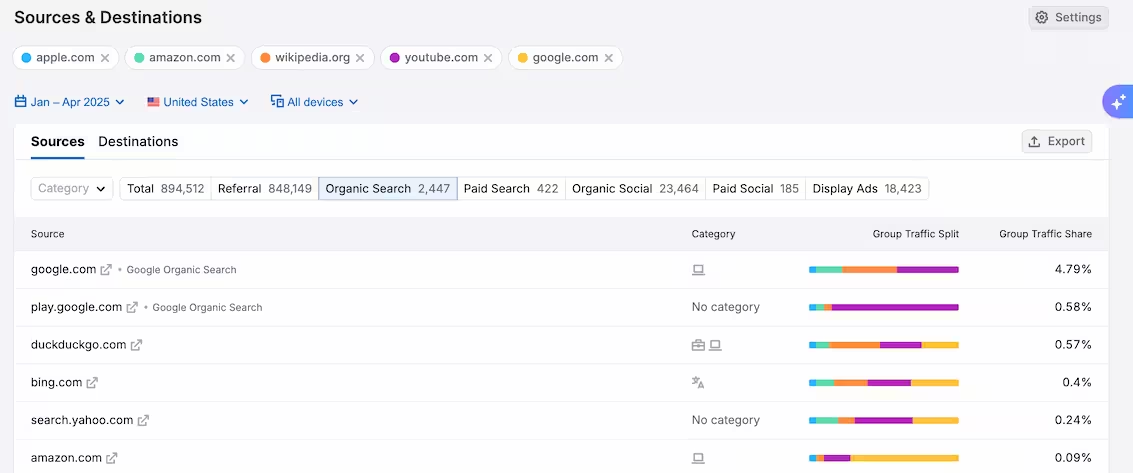
“The insights can be used to not only make an informed purchase decision, but also to grow a site’s presence, visibility, and performance during the post-acquisition stage,” states Blake Hutchinson, CEO of Flippa.
While Flippa uses traffic data to evaluate individual properties, Startup Blink uses API data to take an even broader view of investments.
Startup Blink, an innovation economy research platform, helps startup founders choose the best location to meet their business needs.
They use data from Trends API to fuel their popular startup map to:
- Measure traffic volume for startups in 1,000+ cities and 100+ countries
- Create granular performance metrics by combining traffic data with economic indicators
- Enable real-time monitoring of regional startup activity and growth trends
- Use traffic as a key health indicator for entire geographic segments
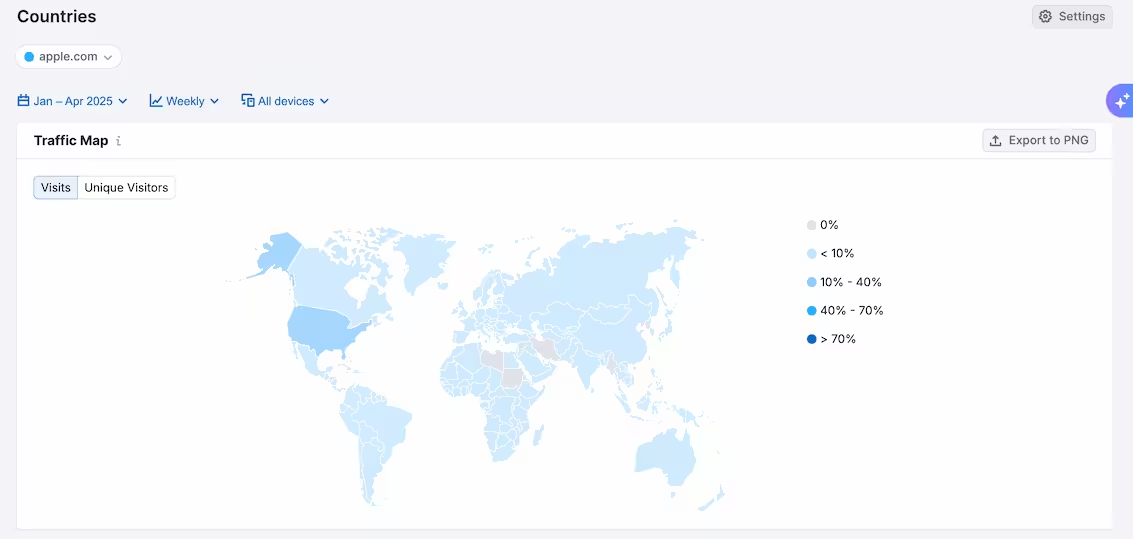
This matters because traditional metrics often miss emerging trends. Traffic data reveals actual market traction.
“Quality is where Semrush stars in our algorithm. We measure quality by looking at how many startups within a given location manage to have high traffic. This is essentially what defines for us that a location is startup-friendly from a quality perspective”, shares Ghers Fisman, StartupBlink’s data manager.
6. Monitor portfolio health
Savvy portfolio managers can closely monitor emerging competitors' traffic patterns with Trends’ real-time performance data.
These insights reveal when competitors start gaining ground in key markets. A sudden uptick in European traffic might signal untapped expansion potential, while declining numbers in core regions deserve immediate attention.
Analyzing this data will also help you make the most of your investments. If companies show slow but steady growth, this might hint at a need to infuse capital to accelerate their growth rate. Other companies might display early warning signs that need addressing before problems escalate.
Market intelligence at your fingertips—unlock Trends API today!
Sales Teams API Use Cases
Sales teams need reliable data to identify promising leads and grow existing accounts. The Trends API enriches prospect information and reveals timely opportunities for account expansion.
7. Enrich data in Salesforce or other CRM
Your CRM should do more than store contact details.
Go from a basic contact list to a power intelligence tool by Integrating your CRM with Trends data. With these new insights, marketers can segment audiences better, and sales reps can spot qualified leads faster.
Here's what happens when you connect the Trends API to your CRM:
- Automated Updates. Your system pulls current traffic data, audience demographics, and industry classifications without manual research.
- Smarter Targeting. Teams see which prospects are gaining market share and which territories show growth. This helps focus effort on the most promising opportunities.
Now, sales conversations start with real context about the prospect's situation, and reps discuss specific opportunities based on actual performance data.
Best of all, sales spend less time researching and more time building relationships that close deals.
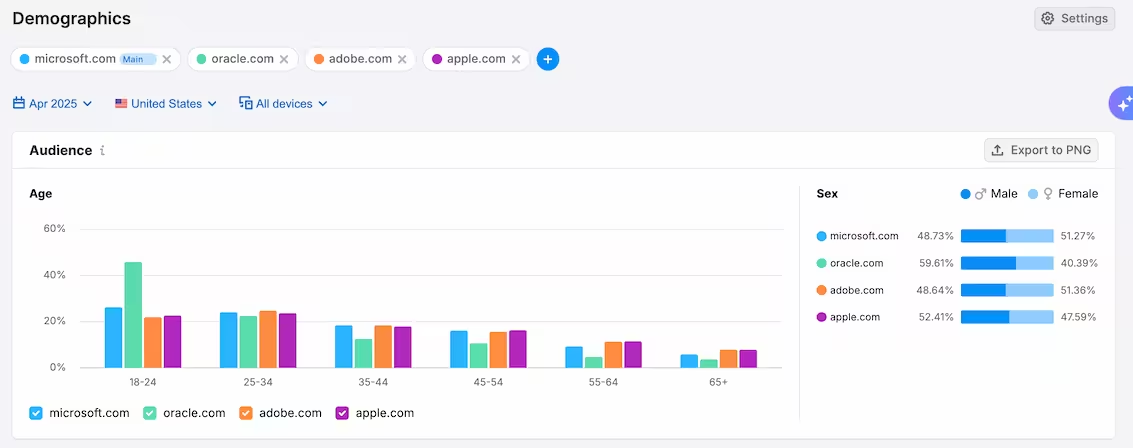
8. Find more upsell opportunities
Sales teams can spot more opportunities to grow existing accounts with Trends API data. By monitoring these patterns across your client base, you turn routine check-ins into strategic planning sessions that naturally lead to expanded deal sizes.
Tracking when clients show strong performance (ex. sustained traffic growth, improved conversion rates, or expansion into new markets) can help you optimize the time you reach out with an expansion opportunity.
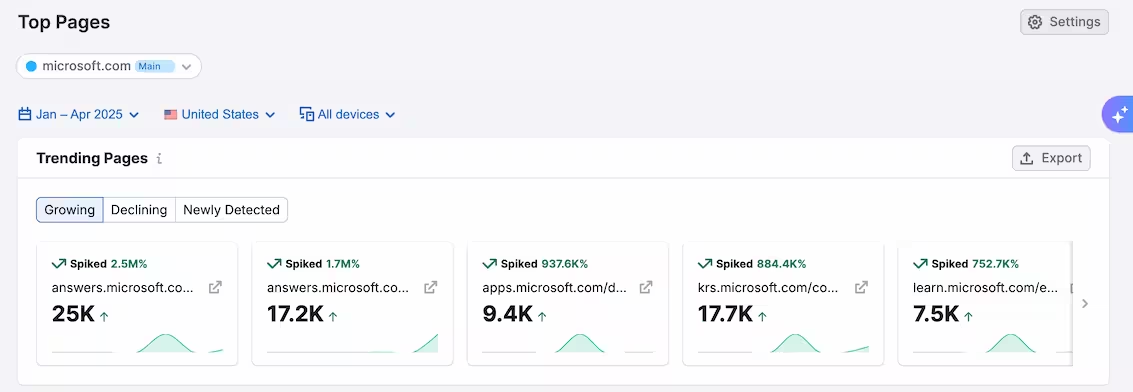
You can also reach out when traffic isn’t so great for clients. If their competitors’ traffic is booming, contact the client with that traffic data. Offer your company’s solution to help the client match (or exceed) the traffic numbers their competitors are bringing in.
If you sell business or online marketing services, data pulled from the API can pinpoint which additional services would benefit each client most. Instead of generic upsell attempts, you can have relevant specific growth opportunities backed by their performance metrics.
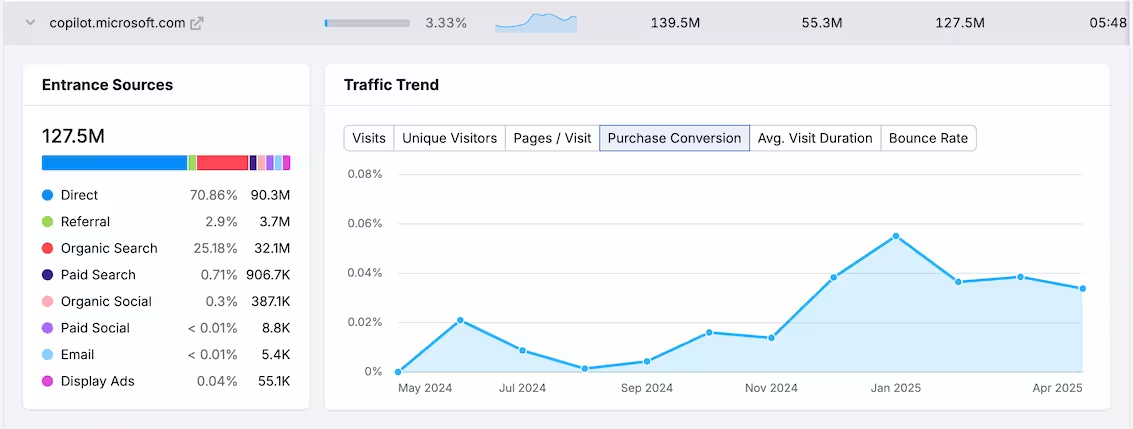
Marketing Agencies API Use Cases
Marketing agencies must consistently prove their value while optimizing client campaigns. The Trends API gives agencies data-driven insights that strengthen client relationships and improve campaign outcomes.
9. Prove ROI backed by data
If you’re a marketing agency, using the Trends API allows you to show value to your clients easily.
Monitor market performance to set realistic targets and show measurable progress. Track visitor patterns, conversion rates, and competitive rankings to demonstrate ROI in actual numbers.

Setting and meeting those targets is especially valuable if you can't directly access client analytics.
Your reports can also compare your improved client performance against key industry benchmarks. When clients see their growth charted against market leaders, they understand the real impact of your strategy and are more apt to keep you around.
10. Optimize marketing strategies
Use competitive data from Trends API to improve your current or upcoming marketing campaigns.
Study traffic patterns to improve targeting, understand audience segments to craft better messages, and track conversion trends to time your launches perfectly. When your agency spots high-performing channels across markets and devices, it can adjust its tactics based on this real-world performance data.
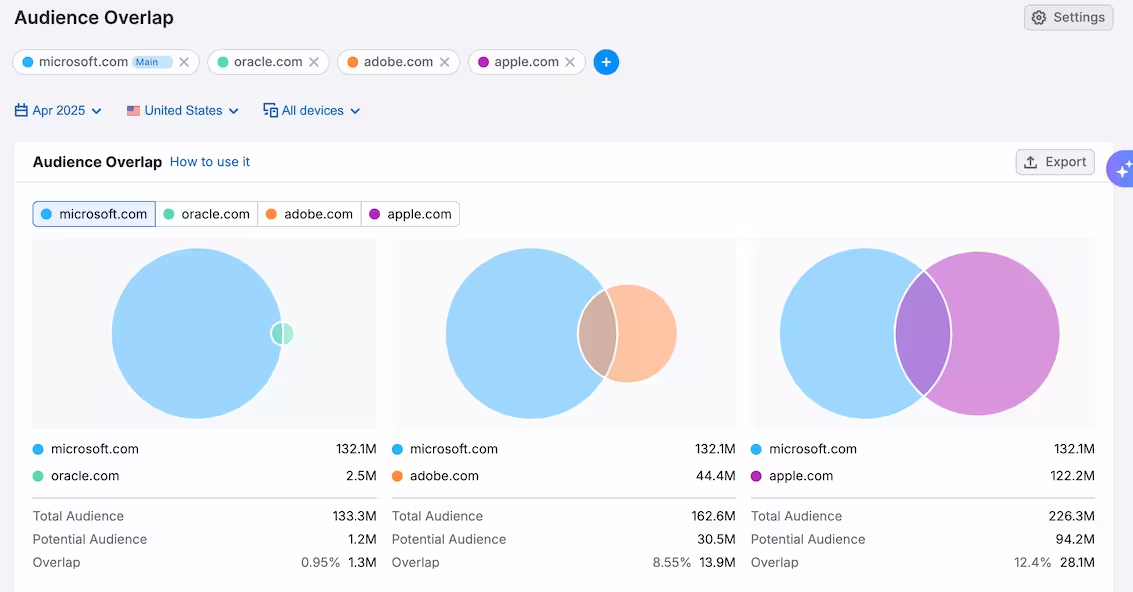
11. Win more clients with personalized, compelling pitches
Impress future clients by bringing relevant, up-to-date data to your pitch meeting.
The Trends API lets you analyze prospects' market position, competitive landscape, and untapped growth areas before your first meeting. At the meeting, show potential clients where they can gain market share and how your approach aligns with real opportunities.
While a stunning slide deck might wow potential clients, a data-driven perspective demonstrating your expertise and the concrete value you'll deliver will seal the deal.
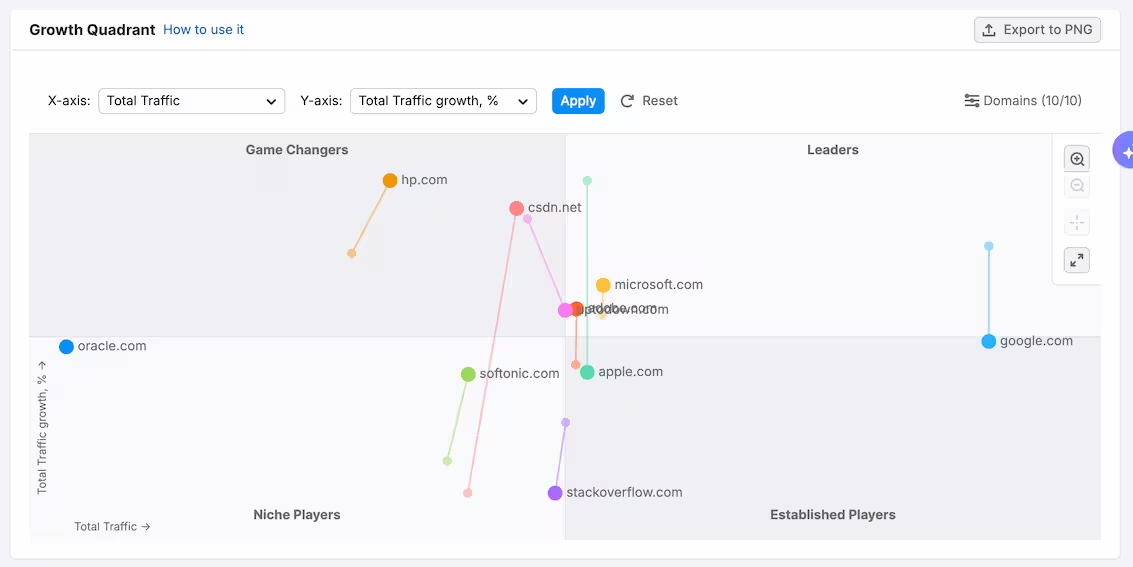
Conclusion
Whether you're analyzing market opportunities, measuring campaign performance, or evaluating investments, the Trends API delivers reliable data that drives results.
Ready to integrate Trends API data into your organization’s operations? Get started with your API key today.

